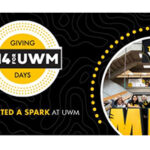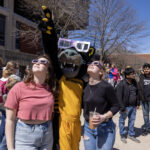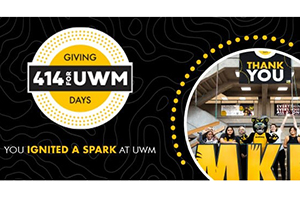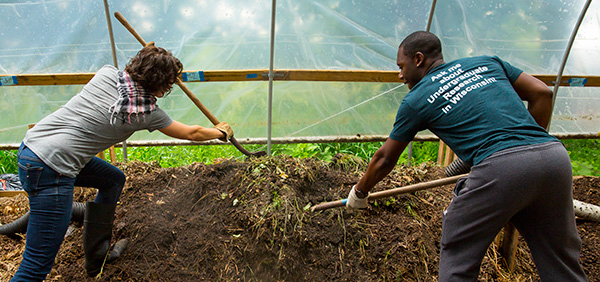
At UWM, the concept of sustainability reaches far beyond efforts to get students, staff, and faculty to recycle plastic and buy “green goods.”
A host of programs across campus aim to reduce UWM’s environmental impact, use state resources efficiently and prepare students for careers in the sustainability professions.
![[sustain_Kate OR sustain_Kate garden] Colleagues describe UWM Chief Sustainability Officer Kate Nelson as “a tireless promoter and developer of ideas.”](https://uwm.edu/news/wp-content/uploads/sites/41/2015/06/sustain_Kate-1c7tr3a.jpg)
“Everything I do at UWM is about transforming this campus into a learning laboratory that connects what students learn in classes to campus operations and potential career paths,” says UWM sustainability chief Kate Nelson, who made the career leap from theater to sustainability with the aid of a 2007 bioscience degree from UWM.
Campus gardens bloom brightly, edibly
One of the best examples of that “living laboratory” may be the campus gardens, established in 2011 next to the east tower of Sandburg Hall.
For a small fee, anyone in the UWM community can rent a plot to grow vegetables. UWM Restaurant Operations grow herbs for campus meals in a roof-top garden on Sandburg. Other plots are reserved for the biosciences course, Practical Approaches to a Sustainable Future.
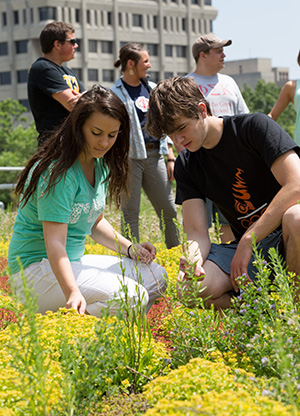
“I’d always wanted to teach a hands-on course that would allow students to work with the soil, and learn all about sustainable agriculture on an individual scale,” explains instructor Mai Phillips, who coordinates the Conservation and Environmental Science (CES) program in the College of Letters & Science.
“Students tend to think of the problems of climate change as so huge, abstract. They say, ‘What can I do? I’m living in a dorm. I don’t know how I can change anything.’ I focus on the small ways that an individual can make a difference,” Phillips says.
A portion of the course’s vegetable harvest is donated to The Gathering, a kitchen for homeless people in Milwaukee.
A “hoop house” near the gardens holds campus food waste that becomes compost. A student monitors the compost’s nutrient levels.
“This is the first year that we haven’t had to buy compost for the gardens,” says Nelson. “We’ve been able to make all our own.”
Even better, the gardens are now watered exclusively with rain water, pumped out of a basin near Sandburg. This storm water management project was a collaboration of students in architecture, engineering and CES.
Bike it, bus it, welcome Bublr!

Associate Vice Chancellor of Facilities Geoff Hurtado received a bachelor’s in architecture studies at UWM in ’74. He believes one of the first key sustainability decisions was made when he was an undergraduate: the university introduced passes that encourage students to park their cars off campus and ride the bus, easing parking headaches in neighborhoods around the university.
New transportation initiatives promote biking. The university recently entered a five-year agreement with Bublr, a local bike-share company, to open six bike-lending stations on campus. Bublr already operates bike-share stations in downtown Milwaukee, which will be compatible with UWM bikes so that students can pick up a bike Downtown, then leave it at campus when the commute is over.
The UWM program is funded by a $300,000 grant from the Student Association Fund, and the stations are likely to open by summer’s end.
Energy Matters
Far less visible that bikes or gardens, the Energy Matters program is a centerpiece of sustainable initiatives on campus. The $30 million state-funded project, designed to increase the energy efficiency of campus buildings, installed digital controls that vary building temperature based on the time of day and number of people in the building. “We have reduced energy consumption 28 percent across campus per gross square foot,” Nelson says, and UWM has updated only a fraction of campus buildings so far.
Online “dashboards” allow people to monitor the energy consumption of these updated buildings. Hurtado says this has inspired friendly competitions in dorms. “The students actually compete on a floor-by-floor basis to see who can outdo whom in conservation,” he says.
Growing green careers
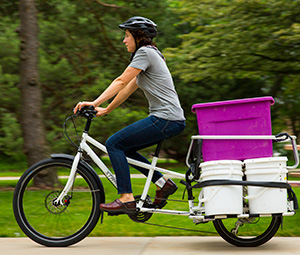
UWM faculty incorporate sustainability into curricula across the university. Phillips believes students in the conservation and environmental studies (CES) program are particularly well prepared after graduation because most complete service learning projects with community partners including the Urban Ecology Center, Wehr Nature Center, Walnut Way and Growing Power. These projects often lead to longer, more in-depth internships, and students graduate with hands-on knowledge of their field and specific career goals.
For the second year in a row, Phillips traveled to Kenya in June with a small group of CES students. There, they completed a study of organic matter and moisture retention in the soil, working closely with a former student of Phillips.
He has transformed dusty, arid village gardens by planting multiple plots using traditional methods, and his work has become a case study in many of Phillips’ UWM lectures. “It became really important for students to see and experience this work,” says Phillips.
Professor Timothy Ehlinger, director of UWM’s Partnership for Sustainability and Peacebuilding, believes in the importance of teaching students to think about sustainability on a scale that starts local but evolves globally.
“We have to recognize that a lot of the things that we do have unintended consequences in other domains,” Ehlinger says. “Our food decisions have tremendous impact on energy, which then has tremendous impacts on global prices, which has tremendous impacts on whether or not a farmer in Costa Rica cuts down forests to grow food to feed cattle.”
Interdisciplinary collaboration can help us predict such consequences more clearly, he says.
Hurtado adds that students benefit from even small-scale sustainability initiatives on campus: “It becomes part of who they are, something they take with them at graduation.”
